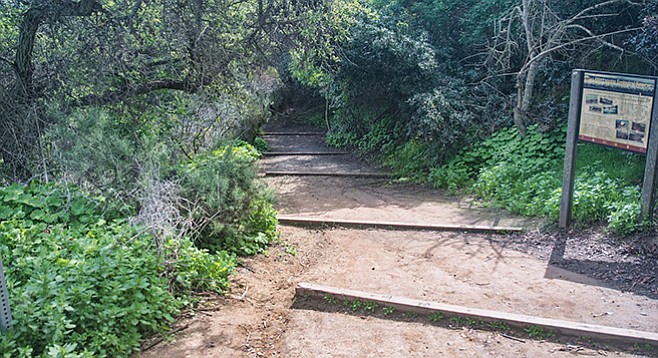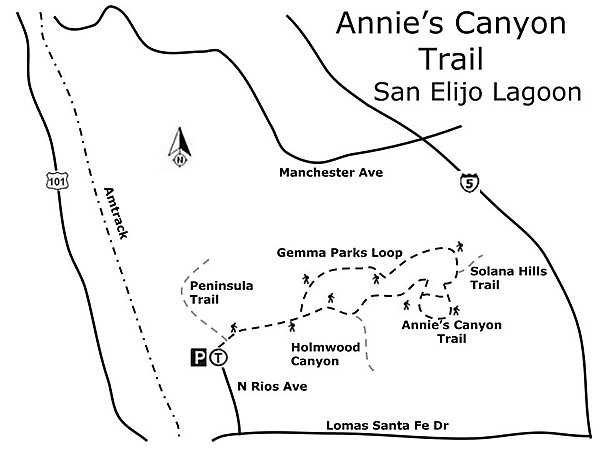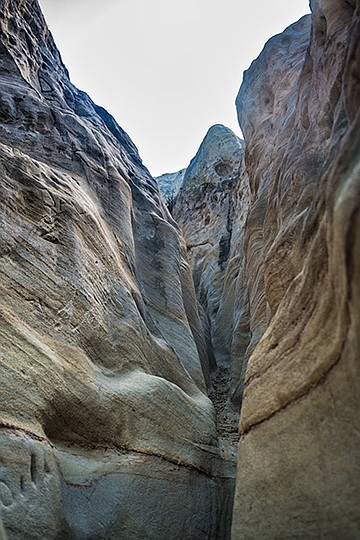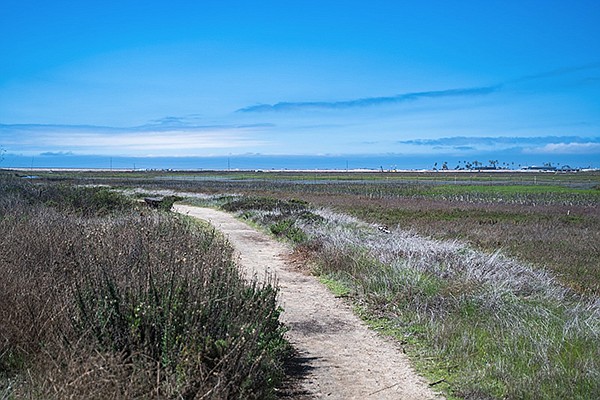 Facebook
Facebook
 X
X
 Instagram
Instagram
 TikTok
TikTok
 Youtube
Youtube

Annie’s Canyon Trail goes through a variety of habitats, including riparian forest, coastal sage scrub, chaparral, and salt water marsh. It also has an amazing slot canyon. There are outstanding views of the ocean, lagoon, and the ongoing major freeway expansion as well as the extensive habitat restoration in the lagoon itself. It is a wild but happening place.

From the trailhead, you begin by walking through a dense riparian forest with overarching willows, cottonwoods, mule fat, and toyon. In about 0.1 mile, you have a viewpoint on the left out into the wetlands. There is much evidence of ongoing habitat restoration here, with numerous recent plantings of native California species by volunteers from the San Elijo Lagoon Conservancy. In another 0.1 mile the trail enters coastal sage scrub habitat, dominated by flat top buckwheat, black sage (currently in flower), lemonadeberry, and California sagebrush. An array of the common fiddleneck (Amsincka intermedia) with bright yellow flowers fills the open areas between shrubs. The even brighter yellow flowers of the large, tree-like cyclops acacia, an abundant but non-native species that flowers in early spring, are just up ahead.

At about 0.6 mile from the trailhead, you reach a eucalyptus grove where you will see a green sign for “Annie’s Canyon Trail” with arrows pointing right and left. This whole area was very run-down and off-limits to the public until funds were donated by a long-time San Elijo Lagoon Conservancy supporter named Annie. With the help of many groups and volunteers, the area was cleaned up and restored, a great gift on behalf of the environment and people. The arrow to the right points to a one-way loop, a strenuous trail that becomes exceedingly narrow as it progresses upward through an eroded sandstone slot. To the left, the arrow points to a
moderate, well-maintained trail with a series of switchbacks. There is breathtaking scenery and views down into the canyon itself that eventually take you to the summit viewpoint. If you go up the slot canyon trail, the more strenuous choice, you will come down to the same summit viewpoint and then loop back through the switchbacks to the trailhead. Both trails are about 0.25 mile long, so either way you walk 0.5 mile for the trip. The slot canyon includes a short diversion into a cave that is still marred by an array of graffiti, the sandstone too delicate for removal. You can see photos of the cave before the clean-up on the internet, as well this video that give you a preview of the trail as it is today.
After exploring Annie’s Canyon, continue your hike to the east on what is now called the Solana Hills Trail. Though currently closed a short distance ahead, it connects to a short trail heading north, out toward the wetlands. As it turns west, it skirts the wetlands, often at the border between salt marsh vegetation and coastal sage scrub. The San Elijo Lagoon map calls this trail the Gemma Parks Loop, so named to recognize the contributions of this naturalist to the preservation of the Lagoon. It is an interpretative trail with many labeled plants, though not necessarily reflecting current reality. On your right, you will find pickleweed, some tule, alkaline heath, California cord grass, and salt grass, among many other salt-tolerant species.

Many birds depend on the wetlands and mudflats. There is a local population of marsh wrens that overwinter in the lagoon and probably nest here as well. The Ridgway rail depends on cord grass for its survival and, as the cord grass continues to make a comeback, it is hoped that this endangered species also will come back.
Directions: (Solana Beach) From I-5, exit at Lomas Santa Fe Drive and continue west one mile to Rios Drive. Turn right on (N) Rios Drive and follow it about 1 mile to the end of the road, addressed on Google as 126 Solana Point Circle. Park on the street at the curb. Although marked on Google Maps as “Mushroom Caves Trailhead,” it is the trailhead for Annie’s Trail and the temporarily closed “Solana Point Circle and Pole Road Trails.” Freeway construction and habitat restoration have led to closure of a number of trails in the San Elijo Lagoon, but Annie’s Trail is open from this trailhead.
Hiking length: 2+ miles, loop. Allow 1.5 hours hiking time.
Difficulty: Easy but includes a strenuous alternative. Elevation gain/loss: 300 feet. Leashed dogs allowed on trail.


Annie’s Canyon Trail goes through a variety of habitats, including riparian forest, coastal sage scrub, chaparral, and salt water marsh. It also has an amazing slot canyon. There are outstanding views of the ocean, lagoon, and the ongoing major freeway expansion as well as the extensive habitat restoration in the lagoon itself. It is a wild but happening place.

From the trailhead, you begin by walking through a dense riparian forest with overarching willows, cottonwoods, mule fat, and toyon. In about 0.1 mile, you have a viewpoint on the left out into the wetlands. There is much evidence of ongoing habitat restoration here, with numerous recent plantings of native California species by volunteers from the San Elijo Lagoon Conservancy. In another 0.1 mile the trail enters coastal sage scrub habitat, dominated by flat top buckwheat, black sage (currently in flower), lemonadeberry, and California sagebrush. An array of the common fiddleneck (Amsincka intermedia) with bright yellow flowers fills the open areas between shrubs. The even brighter yellow flowers of the large, tree-like cyclops acacia, an abundant but non-native species that flowers in early spring, are just up ahead.

At about 0.6 mile from the trailhead, you reach a eucalyptus grove where you will see a green sign for “Annie’s Canyon Trail” with arrows pointing right and left. This whole area was very run-down and off-limits to the public until funds were donated by a long-time San Elijo Lagoon Conservancy supporter named Annie. With the help of many groups and volunteers, the area was cleaned up and restored, a great gift on behalf of the environment and people. The arrow to the right points to a one-way loop, a strenuous trail that becomes exceedingly narrow as it progresses upward through an eroded sandstone slot. To the left, the arrow points to a
moderate, well-maintained trail with a series of switchbacks. There is breathtaking scenery and views down into the canyon itself that eventually take you to the summit viewpoint. If you go up the slot canyon trail, the more strenuous choice, you will come down to the same summit viewpoint and then loop back through the switchbacks to the trailhead. Both trails are about 0.25 mile long, so either way you walk 0.5 mile for the trip. The slot canyon includes a short diversion into a cave that is still marred by an array of graffiti, the sandstone too delicate for removal. You can see photos of the cave before the clean-up on the internet, as well this video that give you a preview of the trail as it is today.
After exploring Annie’s Canyon, continue your hike to the east on what is now called the Solana Hills Trail. Though currently closed a short distance ahead, it connects to a short trail heading north, out toward the wetlands. As it turns west, it skirts the wetlands, often at the border between salt marsh vegetation and coastal sage scrub. The San Elijo Lagoon map calls this trail the Gemma Parks Loop, so named to recognize the contributions of this naturalist to the preservation of the Lagoon. It is an interpretative trail with many labeled plants, though not necessarily reflecting current reality. On your right, you will find pickleweed, some tule, alkaline heath, California cord grass, and salt grass, among many other salt-tolerant species.

Many birds depend on the wetlands and mudflats. There is a local population of marsh wrens that overwinter in the lagoon and probably nest here as well. The Ridgway rail depends on cord grass for its survival and, as the cord grass continues to make a comeback, it is hoped that this endangered species also will come back.
Directions: (Solana Beach) From I-5, exit at Lomas Santa Fe Drive and continue west one mile to Rios Drive. Turn right on (N) Rios Drive and follow it about 1 mile to the end of the road, addressed on Google as 126 Solana Point Circle. Park on the street at the curb. Although marked on Google Maps as “Mushroom Caves Trailhead,” it is the trailhead for Annie’s Trail and the temporarily closed “Solana Point Circle and Pole Road Trails.” Freeway construction and habitat restoration have led to closure of a number of trails in the San Elijo Lagoon, but Annie’s Trail is open from this trailhead.
Hiking length: 2+ miles, loop. Allow 1.5 hours hiking time.
Difficulty: Easy but includes a strenuous alternative. Elevation gain/loss: 300 feet. Leashed dogs allowed on trail.
Comments